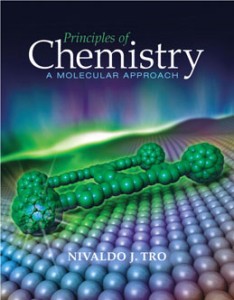Instant download Test Bank for Principles of Chemistry A Molecular Approach, 1st Edition: Tro pdf docx epub after payment.

Product details:
- ISBN-10 : 0321971949
- ISBN-13 : 978-0321971944
- Author: Nivaldo Tro
The Third Edition of Principles of Chemistry: A Molecular Approachpresents core concepts without sacrificing rigor, enabling students to make connections between chemistry and their lives or intended careers. Drawing upon his classroom experience as an award-winning educator, Professor Tro extends chemistry to the student’s world by capturing student attention with examples of everyday processes and a captivating writing style. Throughout this student-friendly text, chemistry is presented visually through multi-level images that help students see the connections between the world around them (macroscopic), the atoms and molecules that compose the world (molecular), and the formulas they write down on paper (symbolic).
Table of contents:
Chapter 1 Matter, Measurement, and Problem Solving 1.1 Atoms and Molecules 1.2 The Scientific Approach to Knowledge The Nature of Science: Thomas S. Kuhn and Scientific Revolutions 1.3 The Classification of Matter The States of Matter: Solid, Liquid, and Gas Classifying Matter According to Its Composition: Elements, Compounds, and Mixtures Separating Mixtures 1.4 Physical and Chemical Changes and Physical and Chemical Properties 1.5 Energy: A Fundamental Part of Physical and Chemical Change 1.6 The Units of Measurement The Standard Units The Meter: A Measure of Length The Kilogram: A Measure of Mass The Second: A Measure of Time The Kelvin: A Measure of Temperature Prefix Multipliers Derived Units: Volume and Density Calculating Density Chemistry and Medicine: Bone Density 1.7 The Reliability of a Measurement Counting Significant Figures Exact Numbers Significant Figures in Calculations Precision and Accuracy Chemistry in Your Day: Integrity in Data Gathering 1.8 Solving Chemical Problems Converting from One Unit to Another General Problem-Solving Strategy Units Raised to a Power Order of Magnitude Estimations Problems Involving an Equation Chapter in Review Key Terms Key Concepts Key Equations and Relationships Key Skills Exercises Review Questions Problems by Topic Cumulative Problems Challenge Problems Conceptual Problems Chapter 2 Atoms and Elements 2.1 Imaging and Moving Individual Atoms 2.2 Early Ideas about the Building Blocks of Matter 2.3 Modern Atomic Theory and the Laws That Led to It The Law of Conservation of Mass The Law of Definite Proportions The Law of Multiple Proportions John Dalton and the Atomic Theory Chemistry in Your Day: Atoms and Humans 2.4 The Discovery of the Electron Cathode Rays Millikan¿s Oil Drop Experiment: The Charge of the Electron 2.5 The Structure of the Atom 2.6 Subatomic Particles: Protons, Neutrons, and Electrons in Atoms Elements: Defined by Their Numbers of Protons Isotopes: When the Number of Neutrons Varies Ions: Losing and Gaining Electrons 2.7 Finding Patterns: The Periodic Law and the Periodic Table Ions and the Periodic Table Chemistry and Medicine: The Elements of Life 2.8 Atomic Mass: The Average Mass of an Element¿s Atoms Mass Spectrometry: Measuring the Mass of Atoms and Molecules 2.9 Molar Mass: Counting Atoms by Weighing Them The Mole: A Chemist¿s ¿Dozen¿ Converting between Number of Moles and Number of Atoms Converting between Mass and Amount (Number of Moles) Chapter in Review Key Terms Key Concepts Key Equations and Relationships Key Skills Exercises Review Questions Problems by Topic Cumulative Problems Challenge Problems Conceptual Problems Chapter 3 Molecules, Compounds, and Chemical Equations 3.1 Hydrogen, Oxygen, and Water 3.2 Chemical Bonds 3.3 Representing Compounds: Chemical Formulas and Molecular Models Types of Chemical Formulas Molecular Models 3.4 An Atomic-Level View of Elements and Compounds 3.5 Ionic Compounds: Formulas and Names Writing Formulas for Ionic Compounds Naming Ionic Compounds Naming Binary Ionic Compounds Naming Binary Ionic Compounds Containing a Metal That Forms More than One Kind of Cation Naming Ionic Compounds Containing Polyatomic Ions Hydrated Ionic Compounds 3.6 Molecular Compounds: Formulas and Names Naming Molecular Compounds Naming Acids Naming Binary Acids Naming Oxyacids Chemistry in the Environment: Acid Rain 3.7 Formula Mass and the Mole Concept for Compounds Molar Mass of a Compound Using Molar Mass to Count Molecules by Weighing 3.8 Composition of Compounds Mass Percent Composition as a Conversion Factor Conversion Factors from Chemical Formulas Chemistry and Medicine: Methylmercury in Fish 3.9 Determining a Chemical Formula from Experimental Data Calculating Molecular Formulas for Compounds Combustion Analysis 3.10 Writing and Balancing Chemical Equations How to Write Balanced Chemical Equations 3.11 Organic Compounds Hydrocarbons Functionalized Hydrocarbons Chapter in Review Key Terms Key Concepts Key Equations and Relationships Key Skills Exercises Review Questions Problems by Topic Cumulative Problems Challenge Problems Conceptual Problems
People also search:
Principles of Chemistry A Molecular Approach
Principles of Chemistry A Molecular Approach Tro
Principles of Chemistry A Molecular Approach Tro 1st
Principles of Chemistry A Molecular Approach Tro 1st Test Bank
Test Bank for Principles of Chemistry A Molecular Approach, 1st Edition: Tro Download





